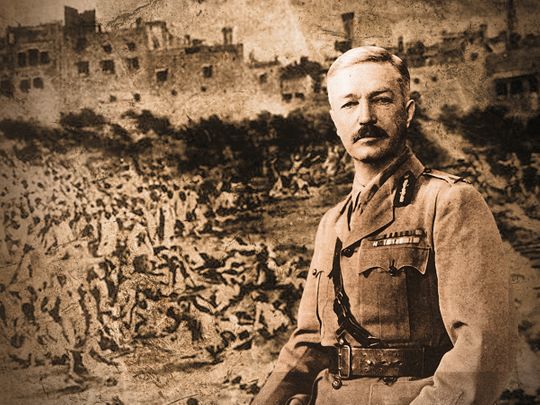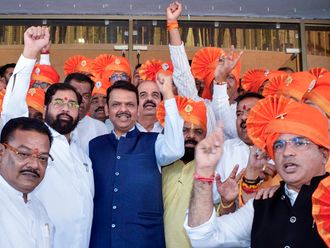
Saturday marks the centenary of a British general gunning down unarmed Indians who had gathered peacefully in a park in Amritsar. In India you only have to mention the name of the park, Jallianwala Bagh, for everyone to know what you are talking about. Yet hardly anybody in the UK has heard about Jallianwala Bagh, let alone knows why the event was one of the worst atrocities of British rule in India. Nor do they appreciate why its legacy still lingers, and colours relations between the UK and India to this day.
The Amritsar massacre fundamentally changed how the Indians saw the Raj (the era of British rule, which ran from 1757 to 1947). It led Mahatma Gandhi, who during the First World War had forsaken his pacifism to help recruit soldiers to preserve the empire, to see British rule as satanic.
Indians, having contributed massively to the war victory both in men and money, were confident that the British would reward them with the sort of dominion status they had already given the white people of Australia, New Zealand, Canada and South Africa. Indians’ hopes were raised when in 1917 the Balfour declaration promised Jews a homeland in Palestine. What they did not know was that the same year the war cabinet had secretly come to the conclusion that it would take Indians 500 years to learn to rule themselves.
Then, after the war ended, instead of liberty the British responded with draconian powers of search and arrest without warrant, and detention without trial. The Indians called it na dalil, na vakil, na appeal — no argument, no lawyer, no appeal. Tensions escalated, leading to British troops killing about 15 Indians; in retaliation five British civilians were killed, and telegraph wires connecting Amritsar to the outside world were cut. On April 13, 1919, General Reginald Dyer marched in.
Dyer led a small party of soldiers to Jallianwala Bagh, an open area of six or seven acres surrounded by high walls in the heart of Amritsar. There 15,000 to 20,000 had gathered, including women and children, some to discuss politics but most to celebrate Baisakhi, the great Sikh festival. Without any warning, and just 30 seconds after he entered the park, Dyer ordered his soldiers to fire. They fired for 10 minutes and stopped only because they had run out of ammunition. By then 337 men, 41 women and a baby of seven weeks had been killed, with another 1,500 injured (the Indians claimed more than 1,000 were killed.) And the carnage could have been even worse. The alley that led to the Bagh was too narrow for Dyer’s armoured cars, otherwise he would have taken them in and used their machine guns.
He also had Indians whipped for not saluting him. But his most novel punishment was reserved for the street where a female British missionary had been assaulted. Any Indian crossing the street between 6am and 8pm had, he said, to “go through on all fours”. The order, enforced by British solders, meant Indians could only proceed “lying flat on their bellies and crawling exactly like reptiles”.
British admirers
Despite this, the British in India saw Dyer as the saviour of the Raj. Although Winston Churchill, then secretary of state for war, privately said Dyer’s action was murder or at least manslaughter, the cabinet committee felt he could not be criminally charged and, while he was forced to leave the army on half-pay, his friends in Britain presented him as a victim of injustice. His admirers ranged from Ulster politicians such as Edward Carson to the Archbishop of Canterbury, who called him a “brave, public-spirited, patriotic soldier”.
More astonishing was the reaction of the House of Commons. With Edwin Montagu, the secretary of state for India, portrayed as anti-Dyer, the House debated a motion to reduce Montagu’s salary, a severe form of parliamentary censure. Among Tories at the time it was not what Dyer had done, but Montagu’s Jewishness that became the central issue. Austen Chamberlain, then chancellor of the exchequer, wrote, “On this occasion all their English and racial feeling was stirred to a passionate display... A Jew rounding on an Englishman and throwing him to the wolves — that was the feeling.”
The Morning Post started a Dyer fund which gave him £26,000 (£1.15 million in today’s money). By contrast, each dependent of an Indian killed by Dyer received Rs500 (£176 today) per body. When he died in 1927, Dyer was given an unofficial state funeral with his coffin borne on a gun carriage through Admiralty Arch.
In the century since then, the British and Indians have grown further apart when recalling this atrocity. In 1997 the Queen became the first British monarch to visit the site of the massacre, but did not apologise: she merely signed the visitors’ book at the memorial. Prince Philip, seeing the memorial which spoke of 2,000 being martyred, suggested Indians had doctored history: “That’s wrong. I was in the navy with Dyer’s son.”
In 2013, David Cameron became the first British prime minister to pay his respects at the memorial. But while admitting it was a “deeply shameful event” he felt you could not “reach back into history” to apologise. Today, Indians are indeed reaching back into history and demanding an apology. Though in the years after independence, India’s first prime minister, Jawaharlal Nehru, stamped on efforts to mark the event, now Indian politicians such as Shashi Tharoor want the British to apologise for the empire and even pay reparations.
It is comforting for the British political class to talk of the Commonwealth as a unique family with many shared memories. The fact is there never was such a family. The British Empire was at best a real-life Downton Abbey, the black and brown people occupying the downstairs, while the whites had the upstairs. For Indians, Jallianwala Bagh is a reminder of what they call Angresso ki Ghulami, the slavery of the British. The word slavery will make many British bristle, but they need to understand why the Indians feel this way.
For Indians, Jallianwala Bagh challenges the myth that British rule was benevolent. Both Narendra Modi’s ruling BJP party and the opposition Congress, fighting the Indian elections until mid-May, are united on this issue. And, with Brexit on the cards, a Britain that seeks to boost its trade with India needs to learn quickly that the legacy of Amritsar has to be addressed and not ignored — or, worse still, forgotten.
— Guardian News & Media Ltd
Mihir Bose is the author of From Midnight to Glorious Morning? India Since Independence.







